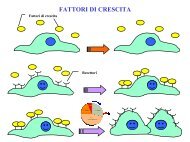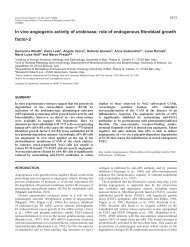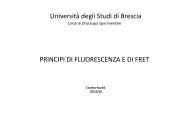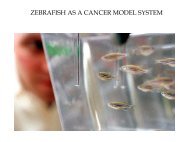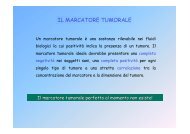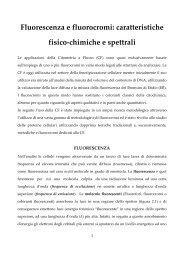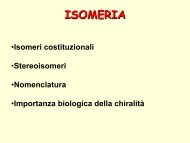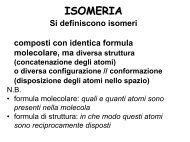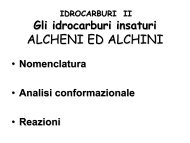Biological activity of substrate-bound basic fibroblast growth factor ...
Biological activity of substrate-bound basic fibroblast growth factor ...
Biological activity of substrate-bound basic fibroblast growth factor ...
Create successful ePaper yourself
Turn your PDF publications into a flip-book with our unique Google optimized e-Paper software.
<strong>Biological</strong> <strong>activity</strong> <strong>of</strong> immobilized FGF2<br />
E Tanghetti et al<br />
tory phenotype. FGF2 <strong>bound</strong> to plastic resists to<br />
extraction with urea, methanol, or ethanol and it is<br />
removed only by drastic treatment with detergents<br />
like Triton X-100 or SDS (Smith et al., 1982;<br />
Rusnati et al., 1997). Accordingly, no FGF2<br />
internalization was observed in cells adherent to<br />
FGF2-coated plastic in which 125 I-FGF2 was used<br />
as a tracer (M Rusnati, unpublished observations).<br />
These data indicate that FGF2 may represent an<br />
angiogenic stimulus also when tightly <strong>bound</strong> to the<br />
substratum.<br />
Under our experimental conditions the amount <strong>of</strong><br />
FGF2 <strong>bound</strong> to non-tissue culture plastic corresponds<br />
to 10 12 molecules/cm 2 (Rusnati et al., 1997). Thus, each<br />
endothelial cell adheres onto approximately 10 7<br />
molecules <strong>of</strong> immobilized FGF2. This causes the<br />
a v b 3 -mediated formation <strong>of</strong> focal adhesion contacts<br />
and actin cytoskeletal organization. The analysis <strong>of</strong> the<br />
components <strong>of</strong> the cell-substratum contact sites indicates<br />
that immobilized FGF2 activates the all series<br />
<strong>of</strong> speci®c stages <strong>of</strong> hierarchies <strong>of</strong> protein interactions<br />
that occur during integrin response, as observed for<br />
typical cell-adhesion proteins like FN and VN<br />
(Miyamoto et al., 1995). Indeed, the presence <strong>of</strong> a v b 3<br />
integrin, FAK, vinculin, pp60 src , and paxillin in cellsubstratum<br />
contact sites demonstrate that immobilized<br />
FGF2 is able to cause integrin receptor aggregation,<br />
integrin occupancy, cytoplasmic tyrosine phosphorylation,<br />
and actin cytoskeletal organization (Miyamoto et<br />
al., 1995).<br />
As stated above, endothelial cell adhesion to<br />
immobilized FGF2 is followed by a rapid and<br />
signi®cant increase in cell proliferation. However,<br />
integrin engagement is not sucient per seÁ to trigger<br />
a mitogenic response. Indeed, GM 7373 cells adhere<br />
and spread also on heat-inactivated FGF2, FN, or VN<br />
leading to the formation <strong>of</strong> focal adhesion contacts in<br />
the absence <strong>of</strong> a signi®cant increase <strong>of</strong> their rate <strong>of</strong><br />
proliferation that occurs only at late time points.<br />
Conversely, overexpression <strong>of</strong> the dominant negative<br />
DFGFR1, tyrphostin 23, and PD 098059 completely<br />
abolish the mitogenic response to immobilized FGF2<br />
without a€ecting a v b 3 -mediated cell adhesion. Moreover,<br />
neutralizing anti-a v b 3 monoclonal and polyclonal<br />
antibodies do inhibit cell proliferation induced by<br />
soluble FGF2 in GM 7373 cells grown on tissue<br />
culture plastic (Rusnati et al., 1997). Thus, interaction<br />
<strong>of</strong> FGF2 with a v b 3 integrin is necessary but not<br />
sucient to transduce a mitogenic signal that requires<br />
the activation <strong>of</strong> a functional TK + FGFR.<br />
Previous observations had shown that integrin<br />
clustering at sites <strong>of</strong> contact <strong>of</strong> FN-coated beads with<br />
®broblast cell surface is accompanied by a transient<br />
accumulation <strong>of</strong> various <strong>growth</strong> <strong>factor</strong> TK receptors,<br />
including FGFR1 (Miyamoto et al., 1996). Here we<br />
show that immobilized FGF2, but not immobilized<br />
FN or PLL, triggers a long-lasting accumulation <strong>of</strong><br />
FGFR1 at the cell-substratum contact sites <strong>of</strong><br />
adherent GM7373-FGFR1 transfectants. Six hours<br />
after adhesion, cell-substratum contact sites, that<br />
represent 3 ± 4% <strong>of</strong> the surface membrane <strong>of</strong> monolayered<br />
cells (Del Rosso et al., 1992), contain more<br />
than 50% <strong>of</strong> total FGFR1 molecules, clearly indicating<br />
that the interaction with immobilized FGF2<br />
concentrates the receptor in these cell membrane<br />
remnants. Accordingly, FGF2-adherent cells showed<br />
a dramatic reduction in the number <strong>of</strong> high anity<br />
125<br />
I-FGF2 binding sites present on the apical side <strong>of</strong><br />
the cell monolayer when compared to cells adherent to<br />
FN or to tissue culture plastic, thus con®rming that<br />
interaction with immobilized FGF2 causes a redistribution<br />
<strong>of</strong> FGFRs at the basal side <strong>of</strong> the cell.<br />
Interestingly, the truncated receptor overexpressed by<br />
GM7373-DFGFR1 cells does not accumulate in<br />
FGF2-induced contact sites, despite its ability to bind<br />
FGF2 in a manner undistinguishable from the wildtype<br />
receptor. Thus, the interaction <strong>of</strong> the extracellular<br />
domain <strong>of</strong> the receptor with the immobilized <strong>growth</strong><br />
<strong>factor</strong> is not sucient to guarantee a long-lasting<br />
accumulation <strong>of</strong> FGFR1 in the focal adhesion<br />
contacts that may require the activation <strong>of</strong> the<br />
intracellular TK moiety <strong>of</strong> the receptor and/or its<br />
interaction with other intracellular proteins. The<br />
ability <strong>of</strong> tyrphostin 23 to prevent FGFR1 recruitment<br />
and the capacity <strong>of</strong> FGFR1 to associate with pp60 src<br />
and cortactin (Zhan et al., 1994) support this<br />
hypothesis. Recently, the vascular endothelial <strong>growth</strong><br />
<strong>factor</strong> receptor VEGFR2/KDR has been shown to<br />
interact directly with a v b 3 integrin (Soldi et al., 1999).<br />
By using the same experimental approaches, we have<br />
been unable to observe a direct interaction between<br />
FGFR1 and a v b 3 integrin (E Tanghetti, unpublished<br />
data). The dissection <strong>of</strong> the molecular basis <strong>of</strong><br />
FGFR1 recruitment in cell-substratum contact sites<br />
by immobilized FGF2 will require further investigation.<br />
Previous observations had implicated ERK activation<br />
in FGF2 signaling (Besser et al., 1995; Giuliani et<br />
al., 1999) and angiogenesis (Eliceiri et al., 1998). FGF2<br />
causes a long-lasting phosphorylation <strong>of</strong> ERK 1/2 in<br />
parental and GM7373-FGFR1 cells, but not in<br />
GM7373-DFGFR1 transfectants. Also, the MEK<br />
inhibitor PD 098059 prevents the mitogenic response<br />
<strong>of</strong> parental and GM7373-FGFR1 cells to immobilized<br />
FGF2. These data emphasize the role <strong>of</strong> ERK 1/2 in<br />
signal transduction activated by FGFR1 occupancy in<br />
endothelium.<br />
Several experimental evidences support the hypothesis<br />
that integrins collaborate with TK receptors in<br />
transducing the intracellular signals triggered by<br />
<strong>growth</strong> <strong>factor</strong>s in target cells (Miyamoto, 1995, 1996;<br />
Kumar, 1998; Giancotti and Rouslathi, 1999). We<br />
report here that immobilized FGF2 interacts with a v b 3<br />
integrin and FGFR1, a€ecting di€erent aspects <strong>of</strong> the<br />
angiogenic phenotype <strong>of</strong> endothelial cells, including cell<br />
adhesion, proliferation, morphogenesis, and motility.<br />
Our data indicate that FGFR1 and a v b 3 integrin may<br />
be favored in their cross-talk by the long-lasting<br />
structural vicinity that occur at the basal aspect <strong>of</strong><br />
the endothelium where they colocalize in cell-substratum<br />
contact sites after adhesion onto immobilized<br />
FGF2.<br />
3895<br />
Oncogene



